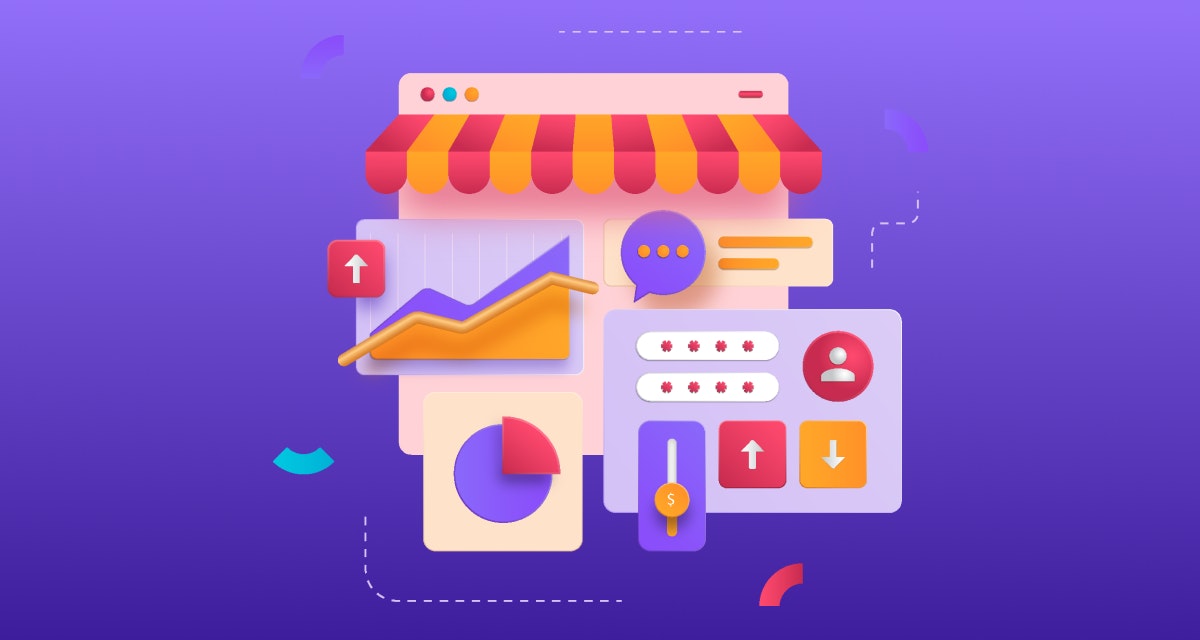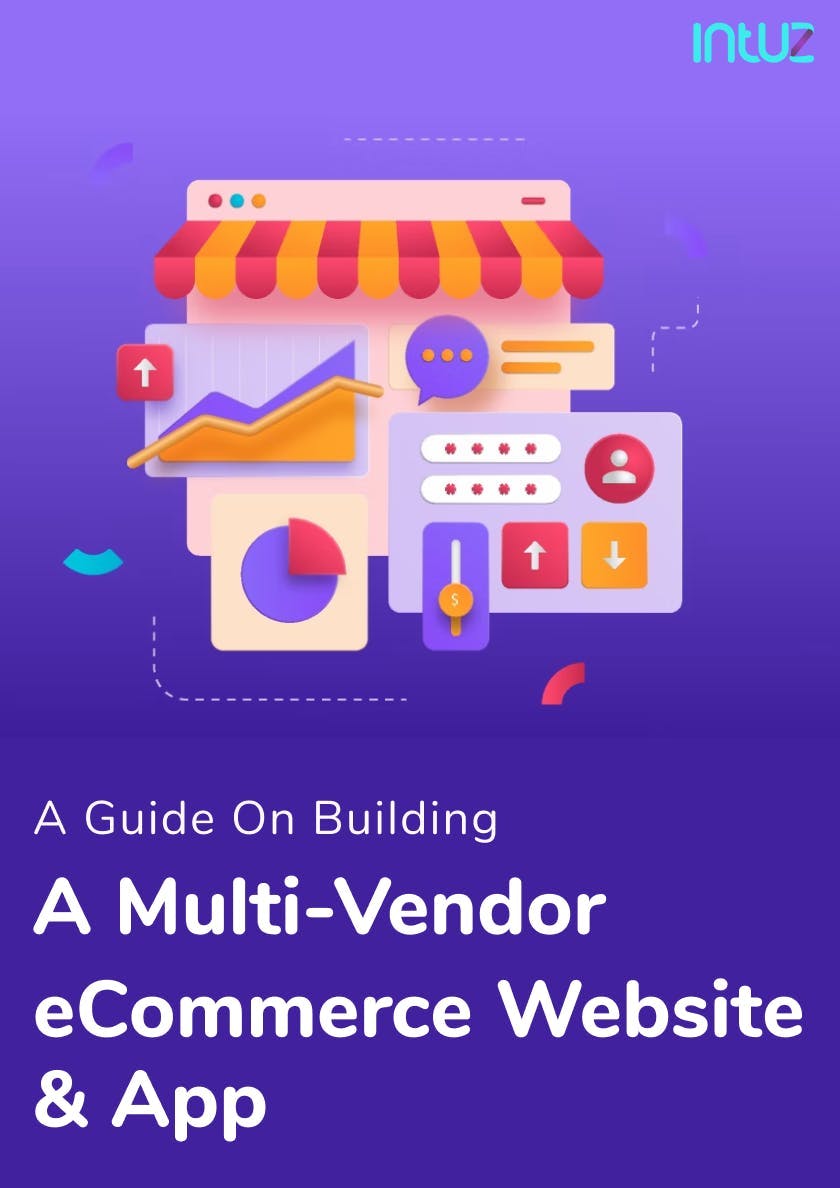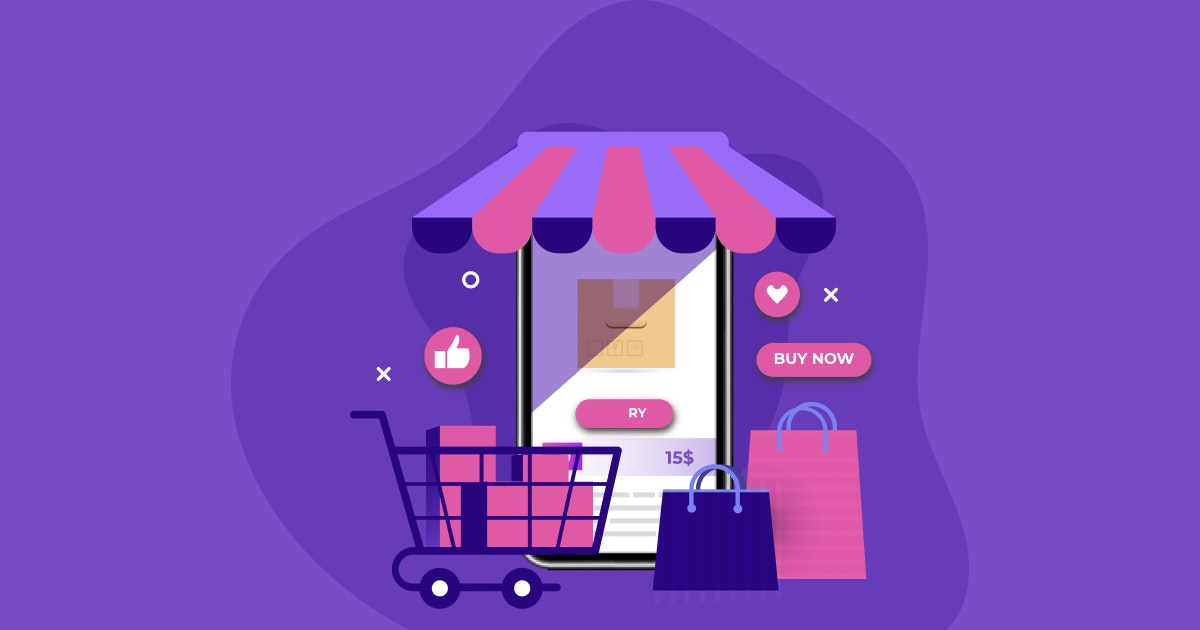The future of eCommerce is all about convenience — meaning, a hassle-free shopping experience. But when you bring multiple sellers and buyers under one roof, there is nothing quite like it. Think Amazon, eBay and Etsy!
The arrangement is called a multi-vendor marketplace, and it benefits all its stakeholders — store owners, vendors, and customers. All parties coordinate to communicate deals as well as ensure products reach the customers on time.
Table of Content
What is a multi-vendor website?
It is an online store where multiple vendors sell their products, and they pay a commission to the eCommerce storefront owner for selling on the marketplace. The vendors sell their own inventory and manage seller accounts provided by the owner.
It is a win-win situation for both parties as they get more customers and can expand their reach. The sellers can collaborate with others in the community and reach out for help in case they hit a technical snag on the website.
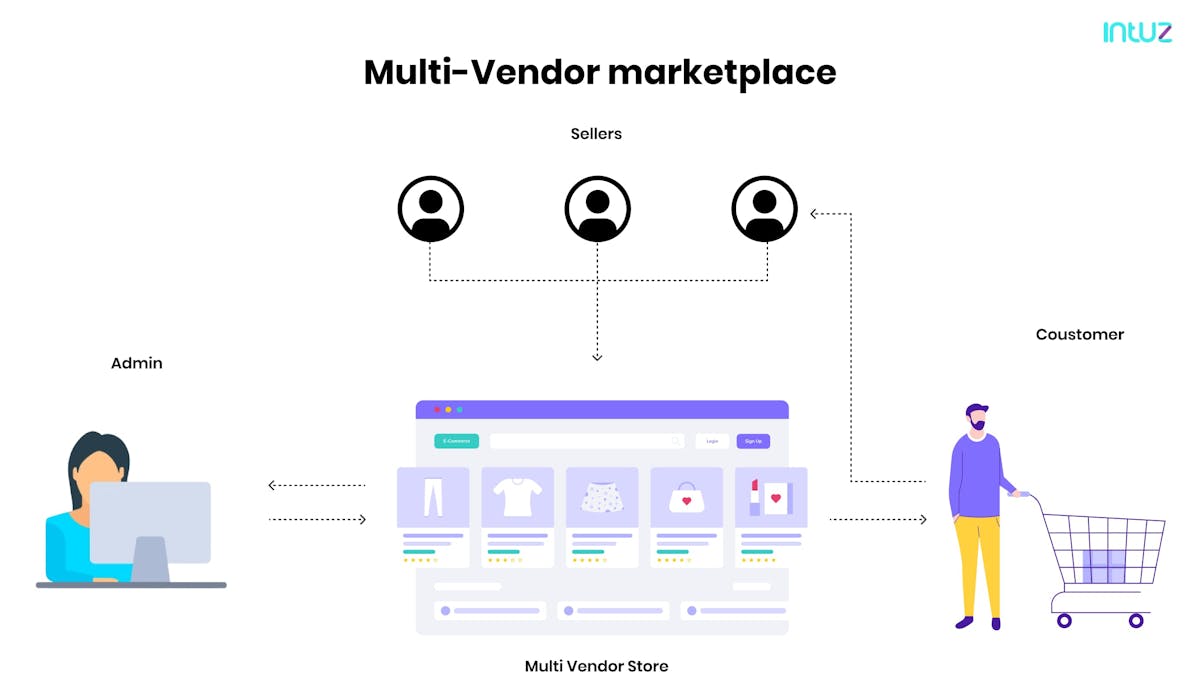
Taking the ‘multi-vendor route’ instills a sense of community for both sellers and customers
Partnering with vendors who sell items similar in nature or target audience allows the former to reach more customers together. They can cater to a larger demographic audience together, meeting their needs as a team.
Interested in a unified brand, customers can also come together to create their own community. The sellers are able to engage with them and learn about them as the buyers flock to the storefront and social media channels.
Shoppers with common interests gather on these digital platforms where the vendors can understand their needs and improve their products accordingly.
Multi-vendor benefits for marketplace owners
1. Earn commissions
By inviting new vendors onto your marketplace, storefront owners can earn commissions on their sales. They could charge a standard commission rate or offer different rates based on criteria like the number of products and audience size.
In such a scenario, it is vital to be explicit about how much the transaction fees are so that merchants know beforehand what to expect when they sell something on the storefront. Lastly, these transactions contribute towards covering costs for site maintenance.
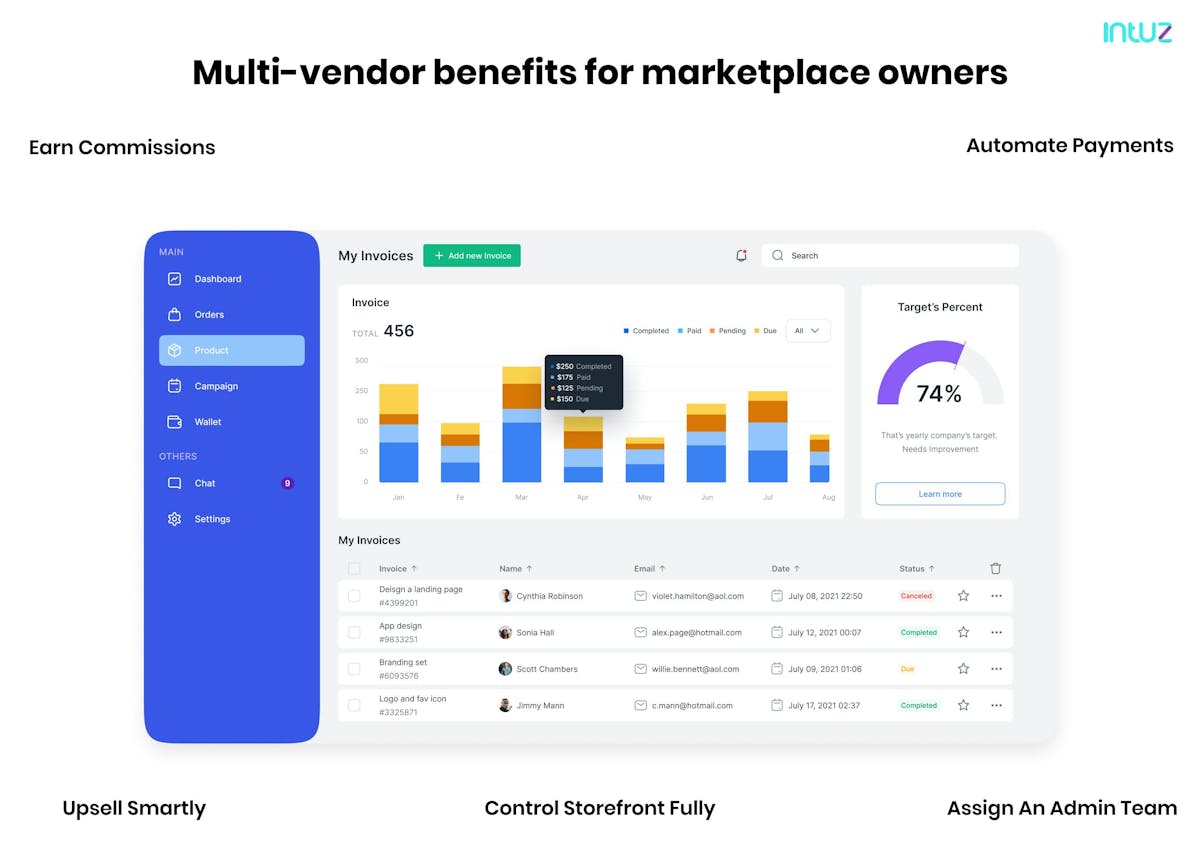
2. Upsell smartly
To make the marketplace attractive to shoppers, the owners should ensure that the sellers with complementary products collaborate. Each seller will have their own audience and can recommend products that go along with theirs to garner more transactions for each other.
For example, some vendors selling kitchenware can collaborate with those selling gadgets. While others offering towels or knives can also team up with them. Each vendor has its own word-of-mouth contacts, websites, and social media accounts.
They can use them all to promote their products and actively direct customers towards the marketplace platform as well. If there are more vendors in a single market place, then it will attract more visitors for every individual seller too.
3. Control storefront fully
Site owners have total control over what vendors can sell on the marketplace. When new vendors apply to join, only those that fit in with the main brand are accepted. The approved merchants create their own product catalog within the digital store. Each product description and detail can be sent for review by the owner before they go live on the storefront.
4. Automate payments
That can help in building long-term relations with sellers on the platform while reducing the owner’s stress too. With the multiple extensions in the market, the owner can quickly set up automatic payments and schedule them for auto-debit.
They must, however, hold onto payouts until orders are actually complete and the return duration has expired. The system can work on per sale, bi-weekly, or monthly payouts considering which is most suitable for the sellers in the long-run.
5. Assign an admin team
It is often best to create a team of administrators who can approve requests from new vendors, update new products, deal with password issues, and manage featured items on the marketplace. By designating administrative users who have control over the site, the owners can spread out responsibility and give their team of admins some tasks to handle on their own.
Multi-vendor benefits for sellers
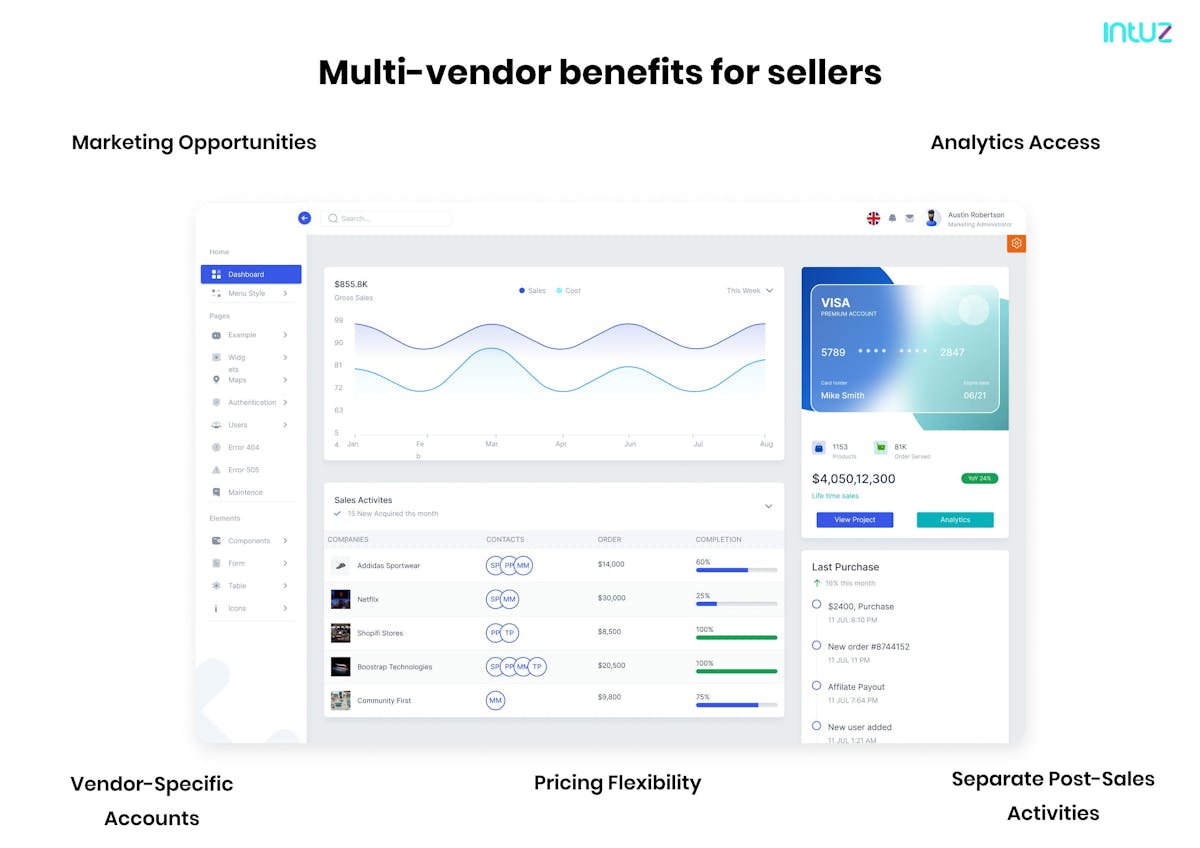
1. Vendor-specific accounts
Vendors have access to personalized shopfronts through an intuitive dashboard, where they can create products and upload images. They can even set prices or describe their creations to tell customers what is available.
They are also able to manage inventory to ensure availability as demand fluctuates. Accurate information can be instantly updated for customers visiting the digital store.
2. Pricing flexibility
Vendors can set custom shipping rates for their products. They are not restricted by a pricing structure. It allows them to decide the charges for each item and the shipping charges can be adjusted as per the product features. For instance, a bulky or heavy item may not be subjected to higher charges. It can be delivered for a small price or may even qualify for free postage.
3. Separate post-sales activities
Trusted sellers must be able to share important information with their customers. They can send order confirmation emails that are customized as per their own brand. Sellers can include details about delivery, instructions for use of products, or disclaimers. They do not have to give full administrative access to anyone.
4. Analytics access
Vendors can easily see their own sales numbers and customer information in an easy-to-read format, through the user-friendly marketplace dashboard. They can use the gathered data to make sure they are listing the right products in proper places.
Studying analytics allows them to figure out new avenues for exposure as well as gauge the performance of their marketing campaigns.
5. Marketing opportunities
On a multi-vendor marketplace, sellers can register their goods. They can opt for physical products, downloadable files, or consultation services. Vendors have the option to use extensions to create campaigns to boost sales of their products.
The data collected during the campaign allows the producers to study customer behavior and improve their marketing strategy.
Setting up a multi-vendor website is an ongoing process. As the storefront owner learns more about customer preferences, they can narrow down their marketing efforts to a targeted customer base.
Automating regular features such as security upgrades, new features updates, customer support, and renewal of subscriptions helps them relax as these high-priority tasks are taken care of. These will help generate extra income while building business reputation.
If you think that dipping your toes in the marketplace pond is ideal for you, then this guide will take you through the entire process of setting up a brilliant online presence. Read on.
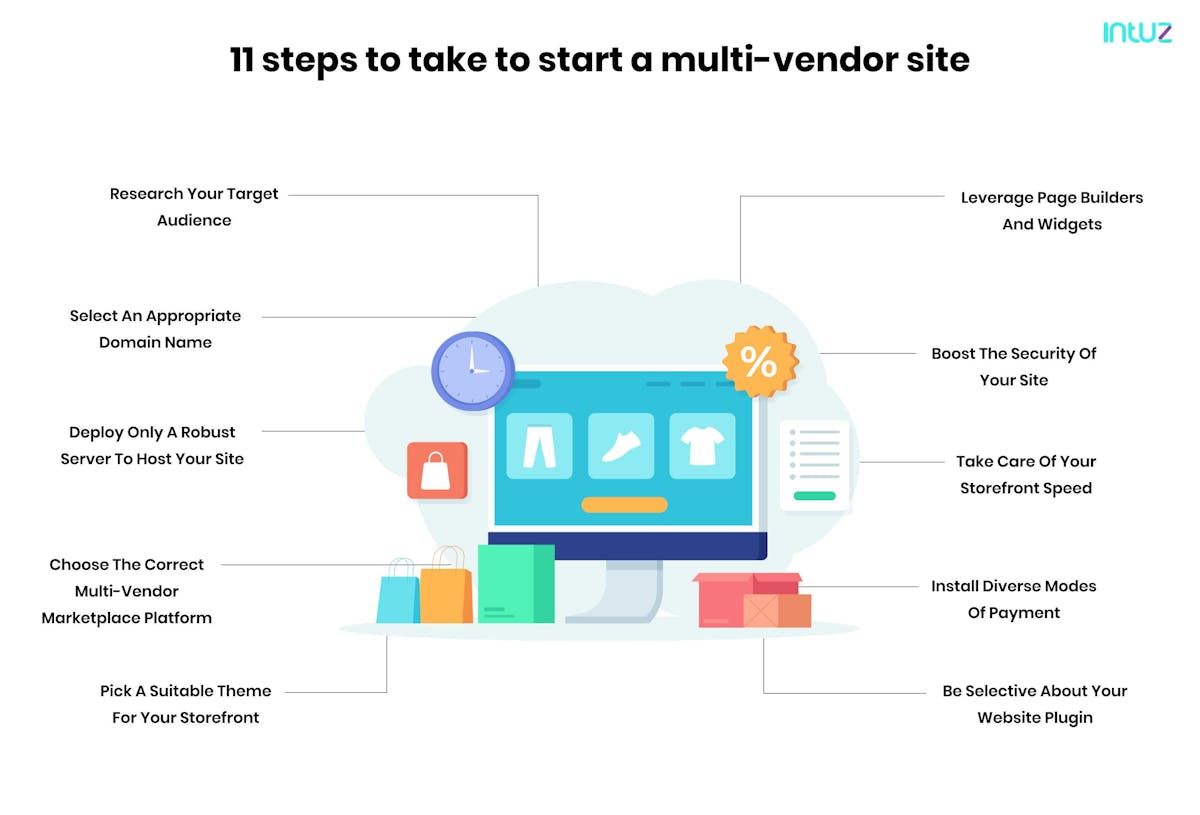
11 steps to take to start a multi-vendor site
The winning edge of this model is getting all vendors on board while letting you earn by taking care only about gaining new customers via platforms such as social media, SEO, paid marketing campaigns, and so on.
You do not need to worry about handling product inventories for your business and can still generate high revenues through commissions. Here is what you need to do when it comes to starting a multi-vendor site of your own:
1. Research your target audience
To begin multi-vendor selling, understand your target audience and their buying behavior. This will help you to determine what products resonate with a sizable portion of the buyer group. If you target the right audience group in terms of demographics such as age, gender, and education, you will enjoy abundant sales right from the start.
2. Select an appropriate domain name
Your domain name should be the result of careful brainstorming and must resonate with your target audience. Popular brands are one of the most valuable assets of a company but building them takes time and hard work.
Keep the following points in mind while naming your brand:
- Keep it easy by picking a short and simple to remember.
- Avoid trademark issues by checking the availability of chosen names.
- Use a universally recognized extension such as .com.
Use a popular domain registrar company to find available domains for your multi-vendor eCommerce website.
3. Deploy only a robust server to host your site
Pick the right server for your online multi-vendor business. It is critical as visitors from all over the world will pour into your website. The constant influx of traffic can make it difficult or even impossible for your site's servers to handle it efficiently on their own.
Therefore, a robust and reliable web hosting solution should be at the top of your list when setting up your online shop. Cloud servers are the best option when you want a low-maintenance, high-traffic web presence.
Cloud hosting will become cheaper and easier to install as time goes on. It is an appealing solution for businesses that require access in all areas of the world at any given moment.
There is no installation charge required with cloud server hosting options. You can also avoid downtime issues easily because your data hosted via this medium has adaptive qualities. It can effectively handle high volumes of traffic.
You will experience minimal downtimes between visitor visits. Cloud servers also make accessing information anytime, anywhere possible and are perfect to provide your digital marketplace the required exposure from various parts of the world.
4. Choose the correct multi-vendor marketplace platform
If you want to build a sustainable business, you must ensure it has a strong foundation. Thankfully, there are a handful of awesome platform options to choose from, including:
a. Shopify
It is a prominent eCommerce platform containing everything you need or look for in an online store. This secure software serves as an all-inclusive bundle, allowing merchants to easily create their website.
You can use it to sell in multiple places locally with the integration of local language support while customizing their website's layout. It has powered over 500,000 businesses worldwide from 175 countries.
Shopify also comes packed with additional tools such as inventory management and social media marketing. It helps you streamline the operations of your eCommerce store.
b. Magento
It is a popular eCommerce tool for online retailers and businesses around the world. The feature-rich application provides increased revenues when installed with additional plugins or extensions on your multi-vendor website.
From the backend, you can manage all your products, including their images, reviews, and inventory details. Magento also allows you to display products by category. The inventory management feature helps you keep track of your stock.
You can deal with customer orders from the backend while a variety of payment methods allow you to accept payments in different ways.
c. WooCommerce
It is an eCommerce plugin that allows you to sell products and services online. It is one of the most highly rated WordPress plugins, providing businesses with advanced features such as reporting widgets and customizable options for addons and themes.
You can use WooCommerce on any website by adding it through a simple installation process using your admin panel. The dashboard widget can be used to check business progress online and there are customization options as well.
There is a range of add-ons and themes available along with versatile payment options such as PayPal, Cash On Delivery, or checks.
d. Dokan
This WordPress plugin is amazing and it works efficiently with WooCommerce that makes creating an online marketplace, like Amazon or eBay, easy. It has helped create more than 60,000+ online marketplaces, and the number of downloads exceeds 1,34,000 times.
By using Dokan, every seller on your site will be given a unique URL to easily manage their products and orders from the frontend of your site.
Dokan is a unique platform that enables you to receive commissions on each sale. It is also great because it supports hundreds of payment gateways including PayPal, Stripe, and MoIP.
e. WP eCommerce
This is an eCommerce plugin that has been downloaded by more than 50,000 users, and is extremely useful for its compatibility with all WordPress themes. Wordpress eCommerce can be easily installed and customized to meet your business requirements.
You can also leverage the multiple payment options offered by the likes of PayPal and also checks. The capabilities of the plugin make it the best choice to increase your revenue streams exponentially.
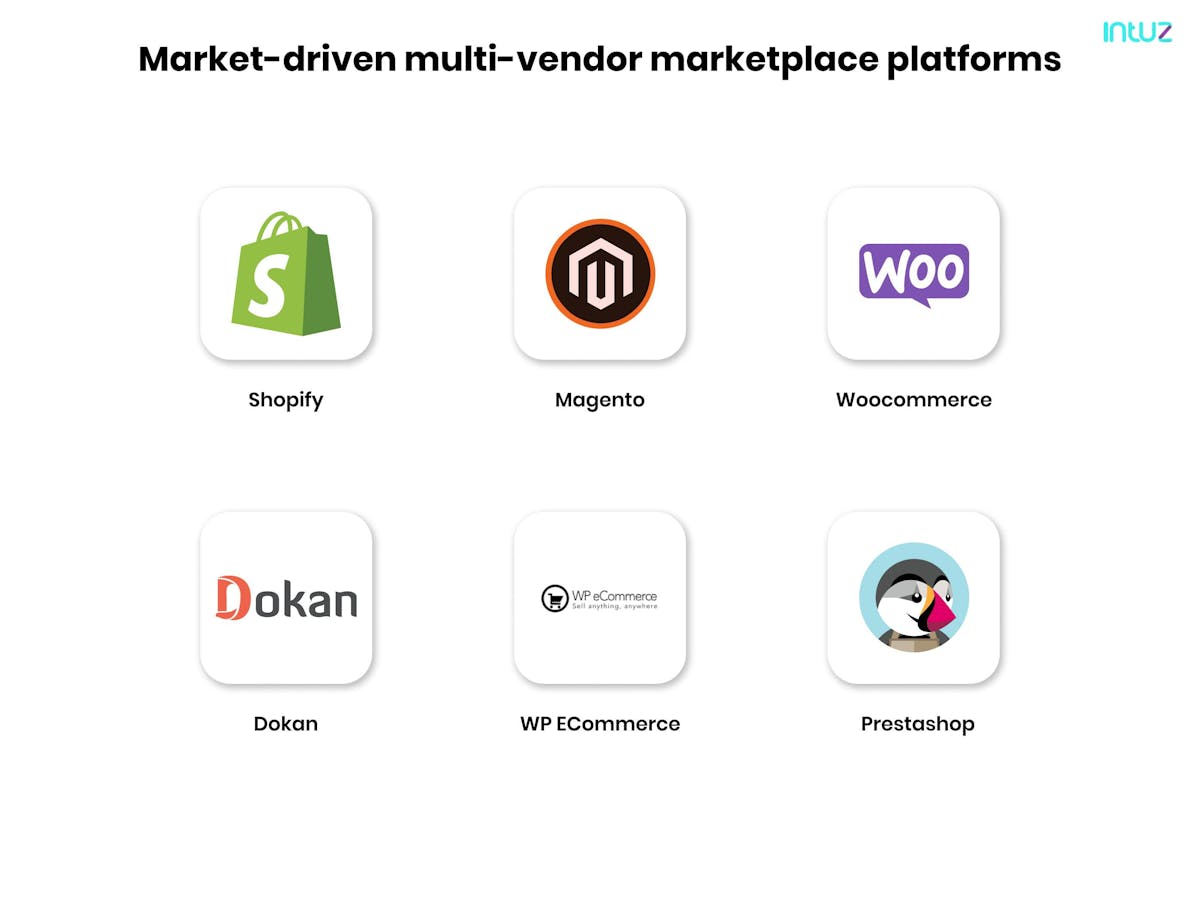
5. Pick a suitable theme for your storefront
If you want to make your eCommerce marketplace solution successful, it is important that the theme for your website be visually attractive and professional.
It must also be user-friendly, so that customers can easily navigate it on their mobile devices or tablets if they are shopping from them instead of a desktop computer.
While any theme will work as long as it meets these requirements, we recommend choosing one with an eye-pleasing design since this has been proven to increase conversion rates by over 30%.
While themes do not directly affect how well sales go over the course of time, they do impact customer satisfaction, and that is important to bring in repeat purchases and referrals.
6. Leverage page builders and widgets
There are hundreds of eCommerce page builders you can use to create specific pages for the site. Important considerations include ease of use, features offered by each site, pricing, and customer service. Following are the popular page builders you can opt for:
- ZeilCommerce is a popular multi-vendor eCommerce marketplace that offers functionality, design, and usability.
- Shift4Shop is another platform that has been popular among beginners looking to start their own marketplace. It is useful for marketers intending to build up an audience and get started with SEO to get noticed in the vast sea of online platforms.
- Shopify is a drag-and-drop eCommerce builder that allows you to easily convert your store into an online marketplace. It offers the best themes, unlimited vendors, products, and customers. In addition, it lets you add multiple commission structures for your sellers.
7. Boost the security of your site
Security is a crucial component for maintaining multi-vendor eCommerce platforms. As your business involves crucial data such as digital exchange of customer info and online financial transactions, maintaining website security becomes necessary.
Customers prefer transacting with businesses they can trust with their data. There are several plugins that can help enhance the safety and reliability of your eCommerce website to ensure you do not have any problems with hackers, viruses, or other cyber threats in the future.
When it comes to securing an online business on the WordPress platform, there is no better plugin than Wordfence Security. It has been designed by professionals who understand how cybercriminals work day and night for breaching websites worldwide.
This powerful yet easy-to-manage tool will scan every single aspect related to domain name registration details as well as hosting server information regularly. It controls malicious activities like spamming comments to ensure the user experience is not affected at any level.
8. Take care of your storefront speed
You are bound to lose a good number of potential customers if your website speed is too low. According to a recent report, 40% of visitors leave if it takes more than three seconds for the page load and 47% expect two seconds or less.
So, when people land on your webpage for the first time, they have already made up their minds whether to transact with you or not in the first three seconds. The following plugins can significantly reduce load times if your multi-vendor website is built on WordPress:
- WP Super Cache is a plugin that compresses pages to lessen the number of requests that a browser makes.
- Optimus, the WordPress image optimizer, reduces image sizes before they are uploaded by your site's users and displayed on their browsers. It helps improve page speed. The plugin cleans up any unnecessary data in your databases.
It allows more efficient queries from search engines as well as makes it easier for website visitors to interact with the content on respective webpages.
- Last but not least, WP Super Minify decreases file size by removing unused code while ensuring compatibility across all devices and browsers. Using this plugin ensures you have fewer files and scripts running making your website faster.
9. Install diverse modes of payment
To get more online orders on your multi-vendor site, allow your customers to pay through various options, both online and offline. You must allow them to select payment options from PayPal, checks, direct bank transfers, and Cash On Delivery.
You can also set up the maximum number of payment methods you want to use by defaulting them in the configuration panel of the multi-vendor marketplace plugin’s settings section. There are many plugins you can use for your eCommerce storefront to offer multiple payment options.
The first is Novalnet Payment Gateway for WooCommerce which allows you to add up to five gateways at once. It also provides customer protection with chargebacks in certain cases of fraud or processing errors.
WooCommerce Stripe Payment Gateway has similar features but does not have the ability to offer as much protection. It lacks support from credit card companies due to the high risk involved during online credit card transactions.
Amazon SimplePay WooCommerce Payments is another useful plugin that allows users to download invoices along with receipts directly through an email after purchasing items on your store. It is a great plugin as customers quickly get proof of goods they have ordered and await delivery.
10. Be selective about your website plugin
Plugins are additional software that can give your multi-vendor site the ability to display content it was not originally designed for. For example, a plugin could allow you to add an online chat feature or show your pricing in currencies other than the default currency.
Plugins can be made to print custom receipts and help customers select options while browsing products using dropdown menus within checkout pages themselves rather than sending them back onto product listings. It is helpful if they want to check different sizes or colors.
The first steps to starting a multi-vendor site are crucial. We have compiled this list of steps that every marketplace owner should consider when they want to set up their online business.
Before you are ready to get started with inviting vendors to launch their shops on your marketplace, you must ensure the basics of your website are in place.
Key aspects of building a multi-vendor eCommerce platform
Ecommerce is growing and businesses are turning away from traditional brick-and-mortar storefronts. But do all digital stores pull enough visitors for the business to make profits or even survive? No, they do not.
This brings the focus of business owners on multi-vendor marketplaces which offers them more than an online space to sell products.
You must consider important features and cater to all parties, namely the admin, vendors, and users. Each party plays a crucial role in the success of your marketplace. Vendors make money for your online store, so you must carefully hand-pick them.
They must be selling high-quality and authentic products to maintain the reputation of your marketplace. The user experience needs to be seamless to help customers quickly browse through multiple products and make a purchase.
Offering a quick comparison of products listed by various sellers across different websites is an added advantage. The admin plays an important role in managing the transactions between the two parties and must be empowered with the right tools.
In this section, we will study what it takes to make the lives of all stakeholders easier on your marketplace. Let us begin:
Key features for the vendors
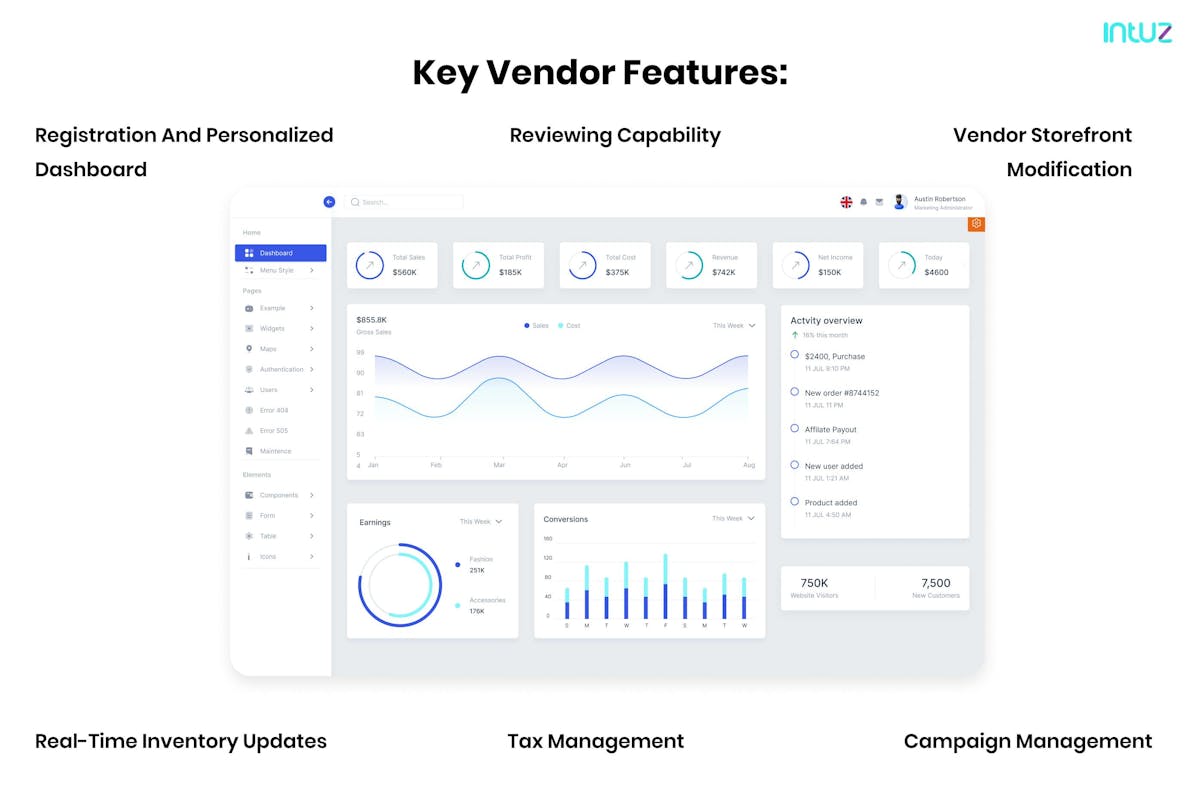
1. Registration and personalized dashboard
Offering a one-stop-shop storefront to your vendors gets them to register all of their best products with you. A multi-vendor marketplace offering high-quality products instantly becomes a customer’s favorite.
Therefore, to get the best vendors onto your platform, you must provide an easy and hassle-free registration process. They should find all information on a custom-built dashboard, so they can track their subscriptions, sales, and payments from your platform.
A personalized profile page and storefront to showcase their products conveys you value their brand. Assistance in managing inventory listings or product details is an added advantage.
2. Real-time inventory updates
Vendors should be able to receive all the information regarding their orders and stock in real-time. This will help them manage inventory better and make decisions on what items need more attention depending on how well they have been selling.
3. Tax management
Every product is subjected to a different set of tax rates depending on where it was manufactured. Adding a tax management feature allows vendors to estimate taxes specific to their region. They can use the information to calculate the selling price of the products they are selling. It also makes reporting and tax declaration accurate.
4. Reviewing capability
The online reputation of a seller matters a lot and also impacts their sales. It is imperative that customers post reviews of the products they are buying.
A feedback collection mechanism also allows vendors to innovate and improve their products, which is beneficial for them in the long run.
5. Vendor storefront modification
This feature allows vendors to personalize their mini-stores on your platform and make them more attractive. Include a feature that allows them to modify fonts, colors themes, and templates to create a customized experience for shoppers.
Adding a multi-store functionality can be a greater advantage as sellers can sell different categories of products while efficiently managing sales and revenue from each of them.
6. Campaign management
Sellers can promote their products on your marketplace and even other digital platforms to engage a wider audience. By providing a PPC advertising and management feature, you can allow them to choose how to spend on their marketing campaigns.
Campaign management tools automate the process to help vendors manage their marketing budget as well as duration of a campaign. When they promote themselves effectively, both of you gain more revenue.
Key features of users
1. Easy navigation and checkout
Customers enjoy shopping more when navigating an eCommerce storefront is easier. You must invest in the UI to make the process — from selecting an item to checking out — as easy as possible. The ability to quickly find products and buy them will make your customers visit your marketplace repeatedly.
2. Product comparison
Users visiting a digital marketplace usually do it through their phones. They may be overwhelmed with multiple product options. Therefore, you must provide them the facility to view and select multiple products at a time. If they can compare prices of all selections, it would ease the decision-making process as well.
3. Multi-product order placements
Customers should be able to combine different products from different vendors into a single order. This will make it easier for them to purchase what they want, while cutting down on their shipping expenses.
4. Order tracking
By giving your customers the facility of order tracking, you win over their trust. Therefore, invest in a system that automatically issues an order number and you are instantly going to improve the customer experience.
The key here is good communication and convenience. You must also make sure that your customer support team knows how to properly track an item through each stage of its journey.
5. Multilingual and multi-currency support
Dealing with a global customer base requires more effort than normal. Your platform must support multiple languages to provide a great experience to customers from different regions.
Multiple payment options allow customers to select their preferred payment method reducing cart abandonment rates. The facility to pay in their own currency earns you more overseas customers as they save on currency exchange conversion fees.
To take the experience a step ahead, you can feature regional favorites or local brands using the geolocation targeting feature.
Key features for the admin
1. Efficient payment system
Timely vendor payments help in maintaining long-term relations with your storefront. A vendor management system streamlines the payment process of your business. Admins can choose to automate or manually pay the vendors.
However, the automated option saves 90% of the time for both parties and reduces stress for the admins. Accurate and timely payments can be made easily through the system.
2. Vendor subscriptions
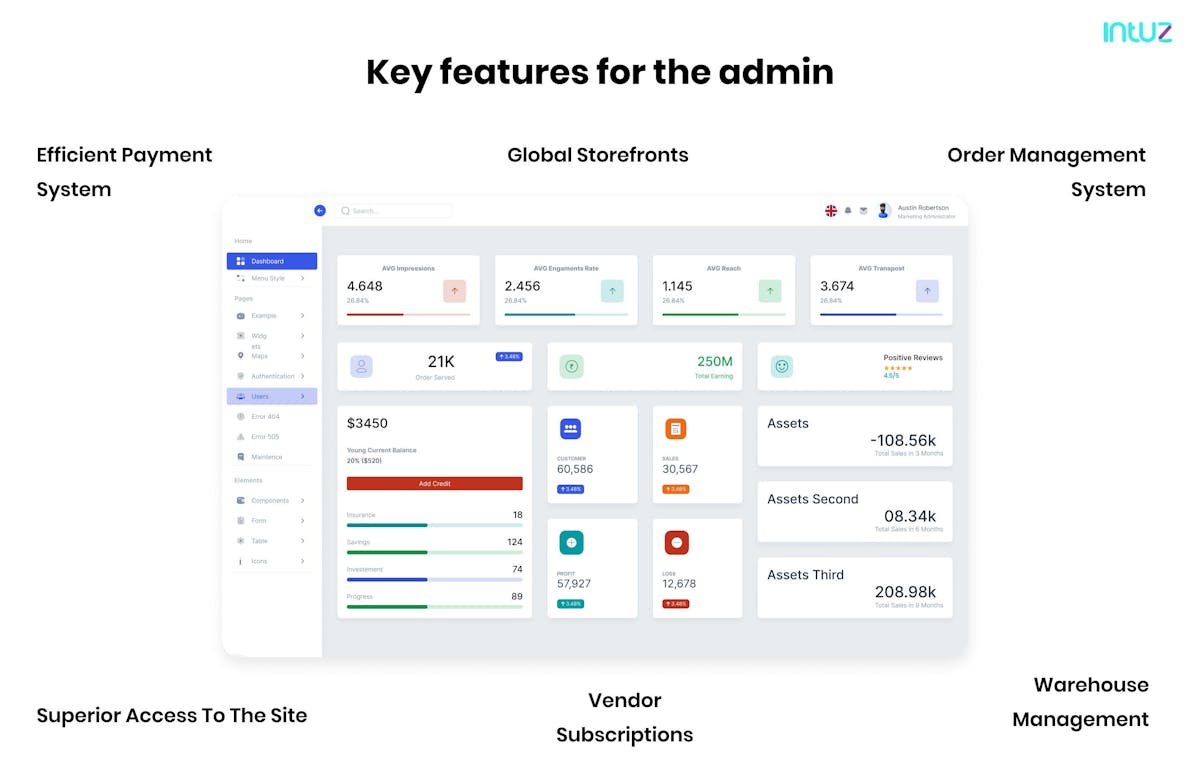
Offering annual or monthly subscription plans to vendors eases the workflow for admins while helping you generate more revenue. The plan gives vendors better selling opportunities while the admin can easily manage inventory details. They must be able to scale the store offerings with fluctuations in demand while being able to manage vendors from the same dashboard.
3. Superior access to the site
Administering a broad-scale marketplace becomes easier when the admin can assign tasks to vendors. Automating vendor registrations ensures all details are captured in one go. Adding a product catalog ensures consistency in product displays and descriptions.
To ensure superior quality of images and descriptions, the admin can manage these features at their end while allowing vendors only to change the prices of their products. All changes and updates must be constantly reviewed by administrators.
4. Global storefronts
Starting your own multi-marketplace is great but can be daunting. You can ease the pressure on your admin by using an existing global storefront. They can register the vendors in the listed product categories while selecting the preferred languages or currencies.
The vendors get exposure to a global audience while sales across the globe will be managed on a single admin panel, thereby increasing transparency.
5. Order management system
Your multi-vendor marketplace lists a large number of vendors and an even larger number of products. The order management system helps streamline orders from a customer. It clearly tells the admin which products were ordered and who the vendor is.
This is useful in cases where a customer may club products from different vendors in a single order. While making it more convenient for the admin, it also ensures timely delivery of all orders.
Instead of going through each purchase separately, admins can easily filter out the orders, product-wise and vendor-wise. It makes order tracking simpler for each party and comes in handy if a client asks for a return or refund.
6. Warehouse management
Inventory management is a crucial function for a multi-vendor marketplace. An efficient warehouse management system with real-time inventory tracking allows admins to manage operations effectively.
They can manage multiple warehouses with ease while optimizing delivery schedules to minimize delays. Keeping track of supplies through an intuitive interface ensures they can meet rising demands with ease.
7. Reportage
Data helps admins take care of vendors and customers better. They can analyze sales reports to determine campaign performance. Studying historical data allows them to predict demand. They can prepare the platform for peaks and lows in shopping.
By providing them with intelligent business analysis solutions, you empower them with actionable data that can be used to grow your business.
Multi-vendor marketplaces are a great way to take your business to the next level. You must add the above features that will help all stakeholders of your business — the admin, vendors, and customers alike.
From user-friendly reporting for admin to easy checkout for customers, and convenient tax management for sellers, you can pick the most useful features for your digital marketplace.
Key aspects of building an ecommerce platform
The eCommerce industry is booming and more players are jumping on the bandwagon as retail platforms recorded 22 billion global visits in June 2020 — right in the middle of the pandemic. As Coronavirus disrupted the way we lived, more people started purchasing goods online.
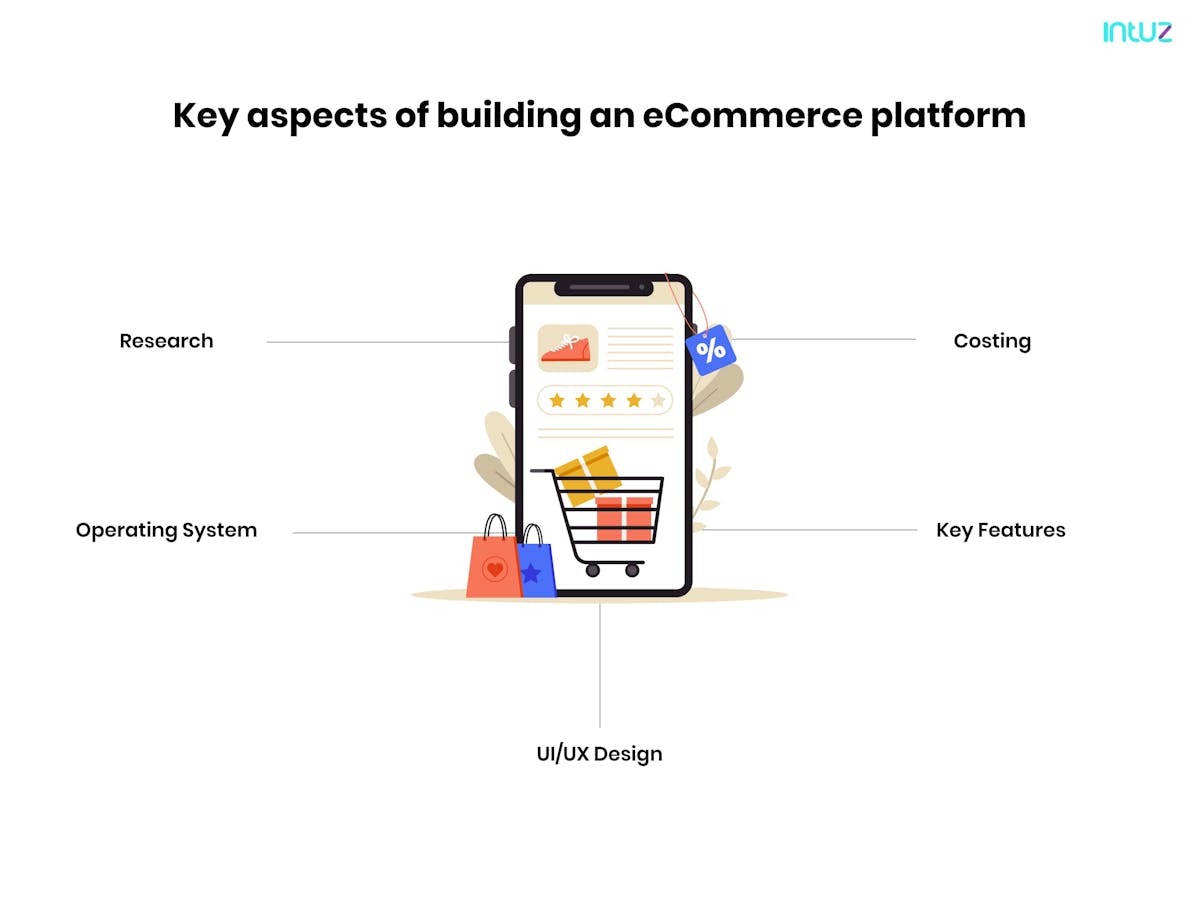
Businesses are therefore investing in developing powerful digital storefronts to meet the rising consumer demands. They want to make sure their customers have access to a high-quality website. They focus on creating engaging content and presenting it on a user-friendly interface.
Combining these with the ease of navigation, as well as regularly amending the store based on customer feedback, makes for a great customer experience. Like brick and mortar stores, customers spend more time and eventually buy more from a well-planned eCommerce store.
Let us take a look at the key aspects of building a multi-vendor platform:
1. Research
Before you start the venture, the research process is crucial to support development. Conducting market research gives you a better understanding of what your customers are looking for.
You can discover what they want from your business and what they are missing out on. In short, identify customer expectations and delivery gaps.
Feedback should be gathered through an initial round of surveying. It will give you an idea of how much budget would be required for developing features needed by users. If done correctly, this feedback can also be useful for making future plans for the business.
2. Operating system
There are a lot of things to consider when choosing an operating system for your digital store. You can choose from web-based or mobile applications that may be Native or Cross-Platform. The decision of which OS is suitable will be based on your research.
Depending upon what your target audience prefers and where they are located in the world (geolocation), you must finalize the OS. For instance, iOS apps may do well in North America while Android is more popular in South America.
Though iOS apps take less time to develop than their Android counterparts, the decision must be beneficial for users. Having a feature-rich, easily navigable app improves the reach of your brand and helps boost its popularity.
3. Must-have features
Your storefront's features and functionality will determine the success of your digital store. You need to make an app that is easy to use and beyond all the necessary features to offer convenience to the customers. A few things to keep in mind are the options for:
- Registration/login to ensure authenticated access to users
- Push notifications to engage your customers
- Filters to ease the search process
- Search bars for quicker access to relevant data
- Real-time order tracking for providing regular delivery updates
- History of past orders to maintain transparency
- Zoom capability for images to ensure customers can see what they are buying
- Seamless integration with CRM, such as Salesforce
- Multiple payment options through debit cards and credit cards such as Visa, American Express, and PayPal
- An easy checkout process complete with category management, so that your customers can browse products at leisure before checking out quickly without any hassle.
- Shipping details so that customers can easily track their orders
- Offers and discounts hold a special place in boosting the sales of an eCommerce store — a discount management tool allows you to provide customized and special discounts.
- The option to rate and review products as new customers go through reviews of existing customers before buying products
- Feedback forms are essential to see how far you have been able to meet customer expectations.
Technology is always evolving, and it is important to stay updated on the latest trends in app development. You can consider deploying advanced features such as virtual assistants, chatbots, and AR voice commands to deliver an upgraded experience.
4. UX/UI design
The design of your storefront is crucial. Not only is it the first thing that attracts users, but it also influences them to spend more time on it. However, keeping it simple makes it more attractive.
A complicated UI with an overload of colors becomes chaotic. Similarly, an overload of tabs and buttons becomes overwhelming for the users. It is therefore important to guide them on how they can access all features of the eCommerce store easily.
A customer-centric design with their name on the dashboard, soothing color schemes, and attractive visuals provides an effective UX.
You can easily achieve this by focusing on the app prototype design, UX/UI design, colors and appearance. It will help you deliver a robust and functional interface.
5. Costing
Carefully evaluating the cost of your eCommerce app development plan ensures your estimation is close to it. You must break down the entire process and calculate the time and resources consumed at each step.
It will be a quick indicator of an approximate amount of money needed for the completion of each step. Keep in mind that although you can calculate a projected cost, you cannot yet predict the final cost at this stage.
As things change during the various stages of development, you may save on some costs or end up spending more than calculated. The needs and requirements of your target audience may also evolve throughout the project’s ideation stages.
It shows the importance of evaluating costs at different junctures instead of just one point along the timeline. Considering all these factors together when deciding on an appropriate budget would help avoid any unexpected financial surprises.
Common multi-vendor storefront challenges
Building an online marketplace comes with its own set of challenges. A multi-vendor website requires more startup capital than a single-vendor eCommerce shop. In addition to the website development costs, you will need to make an extra investment for your post-launch.
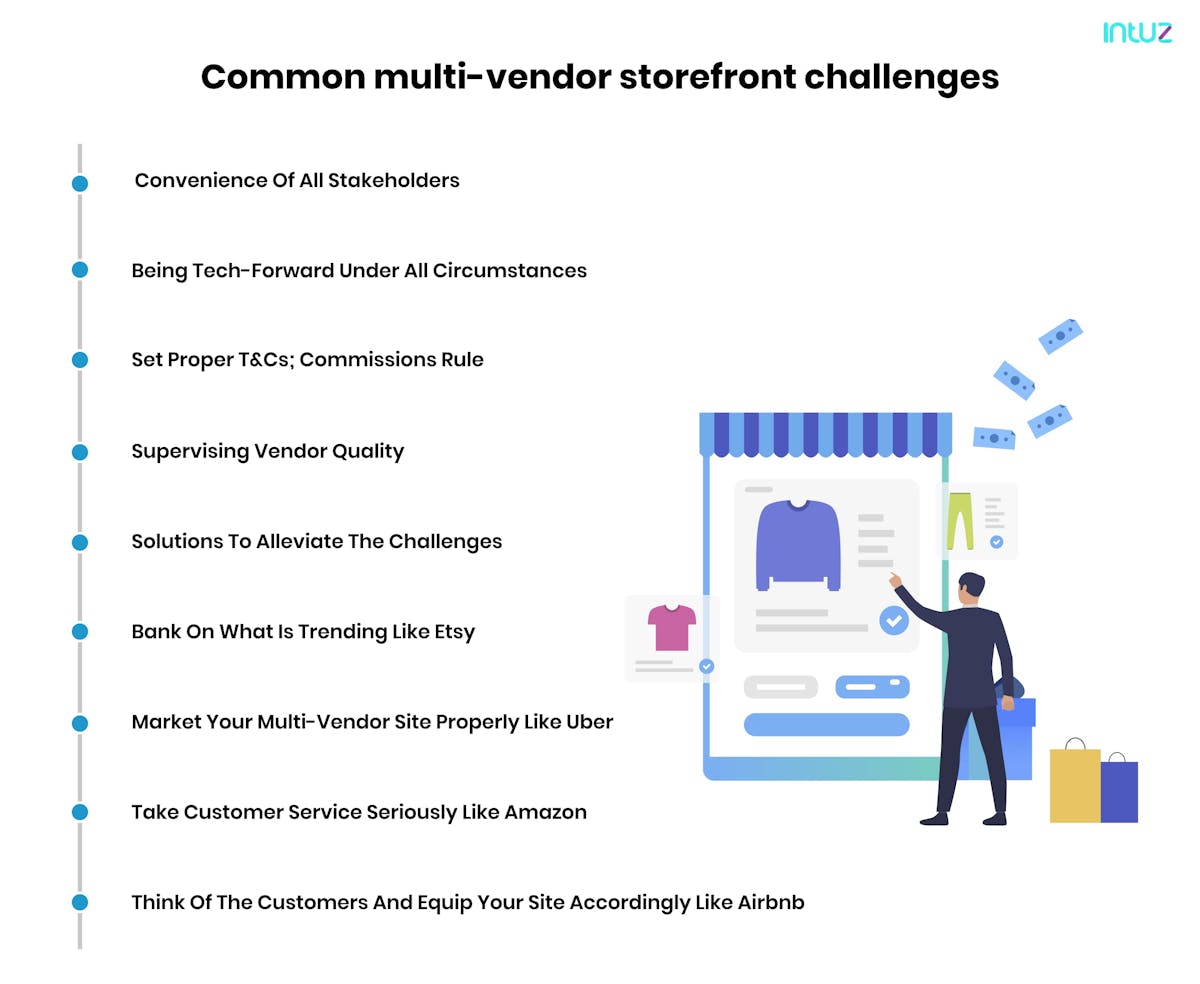
Convenience of all stakeholders
Once the marketplace is live, it needs to attract both buyers and sellers. It is not simple as once the latter sees that there is not a wide selection of products available on your eCommerce website, they will stop browsing.
On the other hand, vendors prefer listing their products on popular eCommerce portals with a large audience base. This increases their probability of finding customers for their products and generating revenue.
The challenge for you is that if the vendors do not start selling their goods with you until your portal is popular among buyers, then customers would not show up unless there are more interesting products for them to buy.
Being tech-forward under all circumstances
To be a successful eCommerce marketer, you will need to match sellers and buyers by using advanced search technologies. You should also help the buyer find what they want while keeping in mind their preferences about pricing, quality, or anything else that would appeal to them.
Sellers expect you to showcase their products to the right set of prospects and boost their conversion rates. To make your job easier with regard to marketing, you can use Machine Learning tools such as website personalization technology to track visitor behavior.
Gathering and analyzing data will tell you exactly who is looking at which products most often. If you want to earn the best deals from your vendors and entice buyers, offer great customer service. Make sure that both parties are satisfied with their interactions on your site before they begin buying or selling products through other portals.
Set proper T&Cs; commissions rule
Vendors will seek alternative channels if they are unhappy with your terms and conditions, or site traffic. Similarly, your website traffic would not be high if you do not offer relevant product choices that satisfy buyers' needs.
Additionally, you must make customers feel good about shopping online as opposed to in-person at brick-and-mortar stores. With great services, it is more likely that this will become their preferred option of acquisition over time.
To get more revenue, you need to sell as much as possible. Commissions are the primary income source but they are less than product margin, so selling a larger range of products will lead to better earnings.
Supervising vendor quality
To keep an eye on the quality of listings and products, you will also have to constantly monitor your multi-vendor website. It will help you in taking timely measures when necessary.
For instance, if a certain vendor is hampering your brand image or their listings do not match your quality, they should be replaced or removed.
This will help keep control over what is happening at all times. Having more interactions with your vendors could avoid the issue from occurring. Therefore, you must provide clear guidelines, keep a check and help out in every way possible for the betterment of everyone involved.
Solutions to alleviate the challenges
In a multi-vendor marketplace business, everything is multiplied and squared. This means that the complexity of daily issues in eCommerce is greater than usual due to problems such as inventory updates, price differences, refunds, or returns resulting from malfunctioning integrations or overselling of not just one vendor but multiple.
Therefore, the complexities associated with fraud prevention and cooperation with law enforcement are even greater. Before you build an eCommerce marketplace, it is critical that you have a complete understanding of the needs and desires of your customers.
Think of the customers and equip your site accordingly like Airbnb
Your marketplace should not only solve existing problems but also provide new services or concepts that have not been available before to ensure its success.
You must enable high-frequency transactions for there to be more liquidity within the virtual space as well as give businesses opportunities to vendors to expand beyond their physical locations by having all types of products under one roof.
The arrangement helps meet customers online at any time and fulfill their demands with minimal effort from either party involved. For instance, Airbnb not only found a solution to the problem that was affecting their customers, but also, they solved it creatively by providing easy-to-use tools that increased trust between hosts and guests.
They included apartment photos and contact information on the site, so users could easily get in touch with the seller and plan an event or trip. A virtual marketplace requires a specific strategy for meeting supply and demand effectively.
Market your multi-vendor site properly like Uber
You can try word-of-mouth publicity and social media marketing. If the organic approach does not work for your platform, then adopting artificial options is necessary. By constantly analyzing the customer's organic search within a marketplace, you can extract some useful insights for your sellers. You can understand this simply through the campaign by Uber.
The company used the local characteristics of San Francisco to find customers. They offered free rides to tech people attending IT conferences. Word-of-mouth was their biggest driver and it helped them create appropriate demand for their offering.
By having all the data about average costs and rates for goods listed on your digital marketplace, you can create and update guidelines. All sellers must follow the rules to make sure they are offering their products at reasonable prices. This will help them prepare more relevant offers while increasing successful transactions and generating higher revenue.
The quality of the product pictures and descriptions will vary across vendors. To provide a consistent user experience, you need to ensure vendors are adhering to unified listing policies that still allow sellers to be unique yet reasonable.
Bank on what is trending like Etsy
Your multi-vendor marketplace may also face a challenge in maintaining the quality of products. Without having an established brand name, it is difficult to convince customers that they are purchasing genuine and high-quality items for themselves or their family members.
When Etsy noticed that there was a lot of demand for owl-related goods, they encouraged their artisans to create more owl-related items. They uploaded a wide variety of products with the owl design to cater to customer needs.
Sellers may also list products that do not match your required quality. You must work on building a strong brand presence across the web to get more traction on your website.
Take customer service seriously like Amazon
If customers are not satisfied with their purchase, they complain to the marketplace representative rather than vendors. This makes it important for marketplaces such as Amazon and eBay to provide a service team that can resolve these issues quickly.
Resolving complaints is time-consuming but it is important to retain customers and build a reputation. To address this challenge, marketplaces need separate teams to handle them.
Competition between sellers on marketplaces is rife. The marketplace's goal and that of the vendors are to have maximum customers, which leads them into price competition.
This encourages the exhibition of more products at the lowest possible prices. It helps increase the number of orders and earn more repeat customers.
How much does it cost to build a multi-vendor marketplace?
Simply put, it varies. To calculate the final cost of developing a multi-vendor website, you must consider many factors. For example, each business and vendor have different demands and that impacts how much a developer charges for their services.
Moreover, there are various stages in development with varying costs associated with them which influence the overall price tag on your product as well. Among the key factors, which contribute to the cost of developing an eCommerce marketplace, are the following:
- Different types of storefronts having varying costs and complications for developers
- Integration with third-party services such as shipping or payments
- The size and complexity needed in design features in terms of widgets and plugins
Hiring a development team for your application may seem expensive or intimidating. However, there are many experts available in the market, and the cost of hiring them can range from $25-$50 an hour, based on their location, skill level, and expertise.
Developing an app can be costly, depending on its size and complexity. For example, it could cost between $5000-$25000 to develop a simple website, but even this cost may go up as you add more features.
The cost of developing a multi-vendor storefront can be anywhere from $15,000-$25,000 with MVP for a singular platform. This is the basic price and it varies according to your business requirements and how complex you want the store to be.
Ready to build the next big multi-vendor site?
The evolution of eCommerce development continues every single day as new innovations come into play constantly. A business needs to stay aware of all changes if they want to meet the expectation of their customers.
Understanding how to make an online shop successful requires some consideration of current trends in technology and consumer behavior.
When your vendors sell on your storefront, not only are they able to gain access and exposure for their brands but also your customers are introduced to new products that they would love.
By focusing on core features such as security standards, content management systems, mobile optimization capabilities, or SEO practices, you will be ready to compete with those ruling the market with a robust online presence.
Are you looking to build an online marketplace platform? Take help from Intuz!
The right set of people will work with you until they complete all of the eCommerce features that are desired by you. In addition, take advantage of our fixed-price packages covering every resource involved. Get started today! You will love the results.
